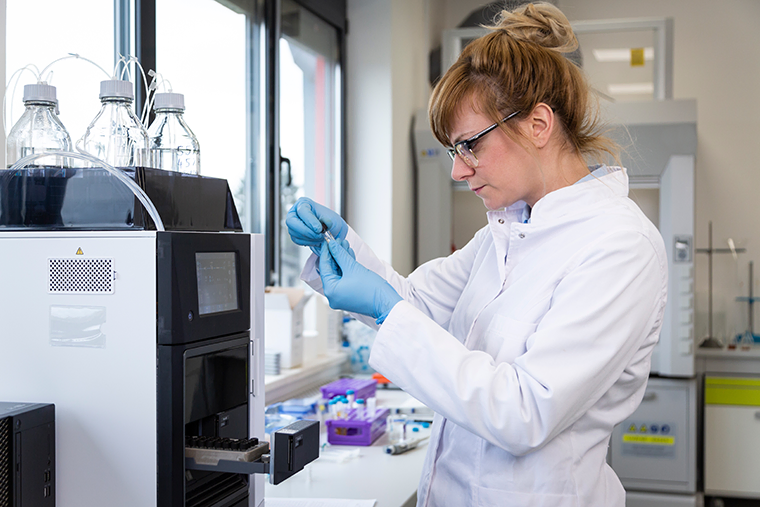Chromatography is an important analytical technique that’s used to separate components of a mixture.
Originally developed by Mikhail Tsvetin in 1900 to separate plant pigments, the method is actually a combination of two Greek words – chroma (colour) and graphein (to write). Hence, chromatography literally means ‘colour writing’.
Continue reading for a GCSE chemistry recap of chromatography, the different types and what they’re used for. You’ll also find some handy practice questions so you can put your knowledge to the test!
In this post:
Introduction to chromatography
Chromatography is a scientific laboratory technique that involves separating the constituent components of a mixture based on their adhesion and molecular weight. As we explain later, specific techniques vary but the basic principles are the same.

The fundamental principles of chromatography involve two stages – a mobile phase and a stationary phase.
So, how does it work? Firstly, the mixture that’s being analysed is dissolved in a fluid solvent, which can either be a liquid or a gas. This is known as the ‘mobile phase’. The mixture is then carried through a system such as a capillary tube, column, sheet, or plate (the ‘stationary phase’).
The different physical and chemical affinities of the constituent components cause them to fix at different places in the system. As a result, the mixture is separated into its various constituent components. Once separated, they can be analysed more closely.
Types of chromatography relevant to GCSE
There are four main types of chromatography:
- Adsorption chromatography
- Thin-layer chromatography
- Column chromatography
- Partition chromatography
Although the specific instruments and mechanisms used in each type can vary, they all follow the same basic principles.
1. Adsorption chromatography
As the name suggests, adsorption chromatography involves the adhesion of atoms, ions, or molecules on a surface. It separates the components of a mixture based on their respective absorbance.
The components with greater absorptivity are left behind, while the components that have lower absorptivity are carried along the mobile phase much faster. Many of the chromatographic techniques used in various industries fall under this category.
2. Thin-layer chromatography
In this type of chromatography, a glass plate (known as a chrome plate) is coated with a thin layer of an adsorbent substance such as silica gel or alumina. The analyte mixture that’s being separated is applied 2 cm above the end of the plate. The plate is then placed inside a jar which contains an eluent fluid.
As the eluent fluid rises up the plate, it carries the various components of the mixture with it. Heavier components are left behind as gravity pulls them down at various levels, counteracted by adsorbent forces.
3. Column chromatography
This method uses an appropriate adsorbent substance that’s packed inside a glass tube column. The mixture to be analysed or separated is placed on the top of the tube. An eluent is then allowed to slowly flow down the column. The components are separated on the internal wall of the column.
The component with the highest level of absorptivity is retained at the top while the other components are separated at different heights based on their respective absorptivity.
4. Partition chromatography
Partition chromatography relies on the polarity of the solutes. In this technique, the mobile phase is non-polar or has low polarity while the stationary phase is polar. The polarity of the solutes determines the extent to which they move from the mobile phase into the stationary phase.
A good example of this method is paper chromatography. The paper serves as the stationary phase while the mixture and solvent serve as the mobile phase. The components separate based on their retention on the paper.
You can read more about how chromatography is used in chemistry here.
Chromatography in practice
Chromatography has applications in many different industries including chemical manufacturing, molecular biology, forensic science, food manufacturing, pharmaceutical testing, and much more.
Pharmaceutical industry
Chromatography is a very useful analytical tool that plays a key role in the pharmaceutical industry. Drug manufacturers use chromatography to detect and analyse compounds for possible contaminants. This is important when it comes to chiral compounds that have two different forms, as a slight variation in the spacing or location of an atom could mean toxicity.
Food industry
In the food industry, chromatography is often used to separate and analyse food additives, vitamins, amino acids, proteins, and other nutritional and non-nutritional components in processed foods. It can also help to determine food expiration dates by detecting the presence of certain organic acids.
One high-profile case of using chromatography in food forensics was the 2013 horsemeat scandal that affected some parts of Europe. While other methods failed to differentiate the contents of processed meat products, chromatography revealed that certain foods advertised as beef actually contained horsemeat.
Environmental science
Chromatography also has an important role in environmental science, where it’s used to detect toxic substances such as perfluoroalkyl substances (PFAS) in the environment. These chemicals can be found in protective coatings of many products, such as shoes and fabrics.
Drug testing
Many medical and drug testing laboratories use chromatography, along with mass spectroscopy, to test for the presence of illicit drugs in blood and urine. The molecules of illicit drugs can be detected with a high level of precision.
The role of solvents and mixtures
Highly pure solvents are used in chromatography as the mobile phase. They carry the mixture being analysed through the stationary phase, which then results in the constituent components being separated in the system. A solvent can be hydrophobic (does not interact with water) or lipophilic (attracted to lipids).
Chromatography questions for GCSE revision
If you want to test your knowledge of chromatography ahead of your GCSE chemistry exam, here are a few questions (just try not to peek at the answers beforehand!).
Multiple choice questions:
- The word chromatography is derived from two Greek words. The first word means colour. Which one is it? (a) graphein (b) chroma (c) eluent (d) analyte.
- Which word literally means ‘to write’ in Greek? (a) graphein (b) chroma (c) eluent (d) analyte.
- Historically, chromatography was developed to separate what? (a) plant pigments (b) petroleum products (c) colours of the rainbow (d) chiral centres
- Who first developed chromatography as a technique? (a) Mikhail Tsvet (b) Archer John Porter Martin (c) Richard Laurence Millington Synge (d) Alfred Nobel
- What is the phase in chromatography that serves as the adhesion surface of the analyte? (a) mobile phase (b) stationary phase (c) active phase (d) inert phase
- What is the phase in chromatography that serves as the solvent? (a) mobile phase (b) stationary phase (c) active phase (d) inert phase
- What type of chromatography uses a glass plate where a thin layer of adsorbent substance is applied? (a) adsorption chromatography (b) thin-layer chromatography (c) column chromatography (d) partition chromatography
- What type of chromatography uses an adsorbent substance that’s packed inside a tube? (a) adsorption chromatography (b) thin-layer chromatography (c) column chromatography (d) partition chromatography
- What are chiral compounds? (a) compounds that have the same chemical formula (b) compounds that have the same molecular structure (c) compounds that have the same chemical formula but different structures (d) none of these
- Paper chromatography is an example of which chromatography technique? (a) adsorption chromatography (b) thin layer chromatography (c) column chromatography (d) partition chromatography
Answers: 1.(b) 2.(a) 3.(a) 4.(a) 5.(b) 6.(a) 7.(b) 8.(c) 9.(c) 10.(d)
Practical application questions
- How is chromatography used in the food industry to determine the shelf life of food products?
- Describe and illustrate how column chromatography works.
Additional resources and study materials
If you want to strengthen your knowledge and understanding of key GCSE chemistry topics, here are some handy resources:
- BBC GCSE Bitesize – a comprehensive, user-friendly revision guide to GCSE chemistry with practice exams.
- MyGCSE Science – a great resource for those who like to learn through reading and note-taking.
- Web Elements – a handy interactive periodic table of elements. Simply click on the name of the element to learn more about it.
You can also find plenty of resources and study guides in our GCSE chemistry resources hub.
Conclusion
Chromatography is a common analytical technique that’s used to separate the constituent components of a mixture. The four main methods are adsorption chromatography, thin-layer chromatography, column chromatography, and partition chromatography. Although they use different equipment, they all involve a mobile phase and a stationary phase. Chromatography has applications in various industries including food manufacturing, pharmaceutical testing, and forensic science.













